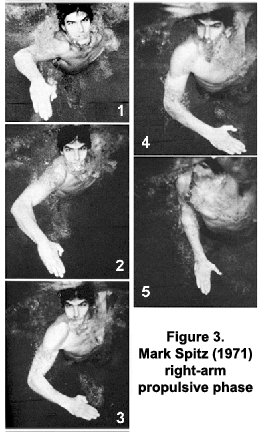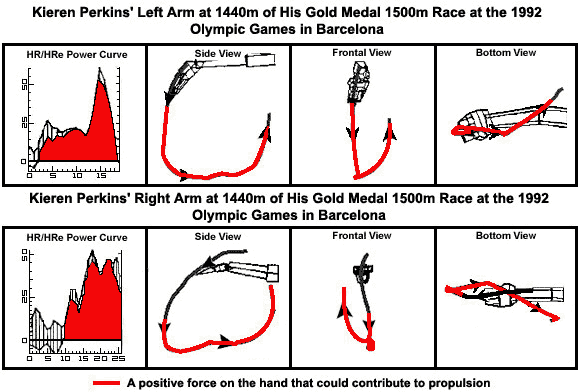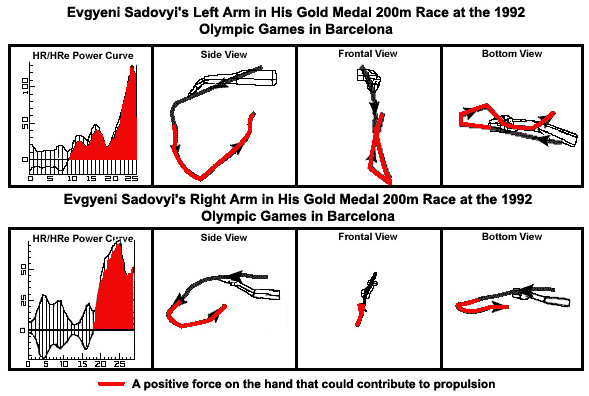SWIMMING SCIENCE BULLETIN
Number 33
Produced, edited, and copyrighted by
Professor Brent S. Rushall, San Diego State University

ACTUAL HAND MOVEMENT PATHS OF CHAMPION MALE CRAWL STROKE SWIMMERS
Brent S. Rushall, Ph.D.,R.Psy.
Introduction
For many years, a common depiction of movement patterns of swimmers has been the illustration of "hand movement paths" as cartoons.  Figure 1 is an adaptation of the generic form of cartoon used to represent the real world of swimming (adapted from Counsilman, 1977, p. 145). In this instance, the illustration was used to justify an "S-shaped" pulling path of a champion swimmer. The intention of the representation was to show how swimming strokes were to be performed. Many cartoons were captioned with a champion swimmers' name, in this instance the athlete being Dawn Fraser, three-time Olympic 100 m Gold medalist.
Figure 1 is an adaptation of the generic form of cartoon used to represent the real world of swimming (adapted from Counsilman, 1977, p. 145). In this instance, the illustration was used to justify an "S-shaped" pulling path of a champion swimmer. The intention of the representation was to show how swimming strokes were to be performed. Many cartoons were captioned with a champion swimmers' name, in this instance the athlete being Dawn Fraser, three-time Olympic 100 m Gold medalist.
Cartoons have been accepted as being representative of actual movement patterns. This form of representation still persists today (see Maglischo, 2003). Few, if any, question the reliability and accuracy of the illustrations. Almost all depictions trace the path of the finger tips; implicitly suggesting that the hand extremity was the best anatomical feature to orient one's understanding and teaching of swimming movements.
Single-frame line-drawings do not allow enough license to depict dynamic movements. In the Dawn Fraser illustration, the movement path is relative to the body, which in this instance is fixed. However, Dawn Fraser's body rolled during her crawl stroke pulling action for both her arms. Rotation about the central axis serves to cancel some of the lateral movement of the hand and arm relative to the body. When her stroke is traced relative to the water, the counter-movement of the body alters the degree of "S-bend" shown in the cartoon. A different image is developed to that of this cartoon.
The "S-shaped" path of a crawl stroke pull has been promoted as worthy of development and even exaggeration so that lift forces will be increased. The opposite is true. The curved path of a crawl stroke hand movement is due mainly to body roll. When the arm is simulated to move directly backward with respect to a swimmer's reference frame, the path of the hand in the external reference frame is more curved than in actual swimming. This means that swimmers manipulate their movements to somewhat straighten the path of the hand movements. Rather than swimmers adducting the arm to produce the "insweep" and then abducting to produce the "outsweep", as commonly demonstrated by coaches, [and still reported in the most recent swimming "textbook" -- see Maglischo, 2003] swimmers actually reduce the curve by abducting in the early phase of the pull (outward rotation of the upper arm), and adducting during the latter phase of the pull (Hay, Liu, & Andrews, 1993).
 To understand the more accurate reproduction of movement patterns, it is important to study the paths relative to the water and to discard the confusing and "unreal" relative-to-the-swimmer cartoons. The illustration in Figure 1 has no validity in real life and does not represent actual events. To his credit, Counsilman (1977) did include illustrations of relative-to-the-water patterns, most of which did not support the popular descriptions of the day that were discussed.
To understand the more accurate reproduction of movement patterns, it is important to study the paths relative to the water and to discard the confusing and "unreal" relative-to-the-swimmer cartoons. The illustration in Figure 1 has no validity in real life and does not represent actual events. To his credit, Counsilman (1977) did include illustrations of relative-to-the-water patterns, most of which did not support the popular descriptions of the day that were discussed.
Figure 2 is another cartoon (Schleihauf in Counsilman, 1977, p. 235). It depicts Mark Spitz' hand movement path in crawl stroke relative to the water. While this illustration has been used to "teach" the "correct" way to pull underwater, a cursory analysis raises some concerns about its accuracy, and therefore, authenticity.
The pull is that of Spitz' right arm. In the side view, all vertical movements occur well in front of the outstretched hand. However, for the same swimmer and hand, in the bottom view image, some of the vertical movements occur under the hand. The whole action is different for each image section. Which is the correct depiction? Similarly, in the front view, virtually all the movement path occurs "inside" the shoulder-point line. However, in the bottom view, a considerable proportion of path is depicted as being outside of the right shoulder point. Which is the correct depiction? How actually did Mark Spitz swim?
 Counsilman (1977, pp. 150-151) included some head-on photographs of Mark Spitz swimming crawl stroke. Figure 3 is an adaptation of the images of the propulsive phase of the right arm pull. The reader should reconcile the photographs of these real-life actions with those depicted as cartoons in Figure 2. Which is the best representation to communicate the actual right-hand movement path of Mark Spitz?
Counsilman (1977, pp. 150-151) included some head-on photographs of Mark Spitz swimming crawl stroke. Figure 3 is an adaptation of the images of the propulsive phase of the right arm pull. The reader should reconcile the photographs of these real-life actions with those depicted as cartoons in Figure 2. Which is the best representation to communicate the actual right-hand movement path of Mark Spitz?
Whether illustrations are cartoons or photographs, it is important to display and describe actual events, rather than those of theory or fantasy. However, there are other problems with these "classical" representations. One is the movement paths are smooth in scope and transitions. Another is the custom of displaying only one arm of the swimmer. It is implied that the picture is "the" pulling pattern of both arms and that movement patterns are mirror images of each other.
Another difficulty with cartoon representations is they normally are taken at training and do not necessarily represent stroke patterns performed at greater velocities in race conditions. That leads to one more question. If a coach were to take the "classical" information and teach others, would those be teachings that would improve training swimming and not racing? It would seem to be more important to instruct swimmers about the techniques of "racing" swimming than the less-related training techniques.
Methods and Procedures
The procedures used to gather the data of this analysis are described more fully by Cappaert and Rushall (1994). Three-dimensional images were produced of 1992 Olympic gold Medalists from films taken during actual Olympic final races. The data produced are not of training-pace movement patterns.
Film recording.
Swimmers were filmed above and below the water. Two high resolution video cameras were placed under the water on the pool bottom in lane 4 and focused upward and toward the center of the lane. Two similar cameras were place above the water on either side of lane 4. They were focused downward and toward the center of the lane. These cameras were focused at the 40 meter mark of the pool. All cameras were synchronized to film the swimmer.
One representative stroke cycle was selected for analysis of each swimmer. Digitized data were determined for every other recorded frame. The underwater records were used to determine underwater movement patterns of each hand from the side, front, and bottom views.
Illustrations.
Force curves show the total amount of work performed, positive work that could assist the swimmer's propulsion, negative work that increased resistance and therefore impeded the swimmer's progression, and the actual work that could have contributed to propulsion (the red colored area in each force curve). The movement paths of both hands are depicted from the side, front, and bottom views. All data are from the same stroke at the same time. In the movement path illustrations, red colored sections relate to the stage of the force curve where some force created by the hand could contribute to propulsion, or more likely, to not reduce forward progression. The red portion of a movement path corresponds to the red portion of the force curve. It is possible to relate where in the movement path propulsive force of the hand is highest. The left and right hand illustrations are of different scales.
Subjects.
Three 1992 Olympic champions were filmed during their Gold Medal races. Kieren Perkins was recorded at the 1440 m mark of his 1500m swim. Evgyeni Sadovyi was filmed at 140 m into his 200m swim. Alexandre Popov was recorded at 40m in his 100 m race.
Results
Illustrations were originally computer generated. For visual effects, elements of the illustrations have been enhanced in red to show where positive hand forces that could contribute to propulsion occurred. Each subject is presented as Figure 4 (Perkins), Figure 5 (Sadovyi), and Figure 6 (Popov).

Figure 4. Kieren Perkins.

Figure 5. Evgyeni Sadovyi.

Figure 6. Alexandre Popov.
The illustrations show the following:
- The left and right hand movement paths are different within each swimmer, that is, stroke patterns are asymmetrical.
- The hand paths are different between each swimmer.
- Forces developed by the hands are different within and between each swimmer.
- Movement paths are not smooth and "ideal", but rather include stages of abrupt change of direction.
Discussion
The established practice of using cartoons to illustrate textual materials concerning swimming strokes is erroneous. Idealized pictures do not represent exact images of actual champion swimmers and largely communicate false information.
The presentation of movement patterns that are smooth in transition and direction does not reflect the abrupt changes in movements that are required to produce propulsive forces on the hands that will accommodate the largely inefficient human structure for swimming. Actions such as the body rotating about the central axis in an oscillating manner require sudden changes when direction is reversed. When the hand is too deep in the early stages of the pull, as is the case with Alexandre Popov's left hand, a sudden adjustment to place the levers and musculature of the arm in a more productive position is required. That adjustment causes a two-peak force curve, the alteration causing a sudden loss in productive power only to regain it when another position facilitates better force production. The reader can determine where other sudden actions cause noticeable force changes in each swimmer.
The traditional procedure of illustrating one hand path of a swimmer implies the depiction as being the "stroke" of the swimmer. However, none of these Olympic champions has similar movement paths for the left and right hands. That is understandable when differences in strength between dominant and non-dominant arms have to be accommodated. The force curves of each hand in each swimmer emphasize the magnitude of the differences between each hand action. If an author claims one illustration as being indicative of that swimmer's stroke, which limb is selected to communicate that false information?
The exactness of cartoons has always been questionable. Usually, authors exhibit license and distort what might have been real or more frequently, invent drawings to fit a biased perception or item of opinion. Cartoon depictions of what to do in swimming strokes should be treated skeptically, ignored, and considered to be symbolic of the lack of reliability and accuracy of communication content. This is a harsh dictum but it is warranted because this form of intended or unintended deception has been persisting over many years in swimming. It is not a satisfactory way of communicating specific information, particularly when there now exists a rich database of actual film footage of champion swimmers captured during superb performances.
Cartoons have been used mostly to "show" developing swimmers how actions should occur, that is, as a teaching aid. When they depict movement patterns that never occur in real-life (relative-to-the body paths), they are neither useful nor productive. When they depict relative-to-the water paths, they have some potential for use only if they are accurate and illustrate the complete swimmer or path.
There is no exact ideal path of hand movement pattern in crawl stroke. There is no common path that includes in- and outsweeps, etc. (compare Perkin's left arm with Popov's left arm). Such descriptions are a figment of an author's imagination or selectivity of data to fit a preconceived notion.
There are too many influential variables that cause intra- and interindividual variations. What then should a swimming coach teach? One productive avenue would be to ensure swimming techniques of individuals adhere to productive principles of biomechanics. Focusing on what, rather than how, propulsion is achieved would accommodate individual needs and idiosyncrasies in movement paths.
Conclusion
The main conclusion of this brief presentation is beware of cartoon-like illustrations of swimmers' hand movements. They are likely to be erroneous and frequently deceptive. It is hoped that their use will decline rapidly and be rejected by publishers and coaches alike.
References
- Counsilman, J. E. (1977). Competitive swimming manual for coaches and swimmers. Bloomington, IN: Counsilman Co.
- Cappaert, J. M., & Rushall, B. S. (1994). Biomechanical analyses of champion swimmers. Spring Valley, CA: Sports Science Associates.
- Hay, J. G., Liu, Q., & Andrews, J. G. (1993). The influence of body roll on hand path in freestyle swimming: A computer simulation study. Journal of Applied Biomechanics, 9, 227-237.
- Maglischo, E. (2003). Swimming fastest. Champaign, IL: Human Kinetics.
- Schleihauf, R. (1977). A biomechanical analysis of freestyle aquatic skill. In J. E Counsilman (Ed.), Competitive swimming manual for coaches and swimmers. Bloomington, IN: Counsilman Co.
Return to Table of Contents for Swimming Science Bulletin.

 Figure 1 is an adaptation of the generic form of cartoon used to represent the real world of swimming (adapted from Counsilman, 1977, p. 145). In this instance, the illustration was used to justify an "S-shaped" pulling path of a champion swimmer. The intention of the representation was to show how swimming strokes were to be performed. Many cartoons were captioned with a champion swimmers' name, in this instance the athlete being Dawn Fraser, three-time Olympic 100 m Gold medalist.
Figure 1 is an adaptation of the generic form of cartoon used to represent the real world of swimming (adapted from Counsilman, 1977, p. 145). In this instance, the illustration was used to justify an "S-shaped" pulling path of a champion swimmer. The intention of the representation was to show how swimming strokes were to be performed. Many cartoons were captioned with a champion swimmers' name, in this instance the athlete being Dawn Fraser, three-time Olympic 100 m Gold medalist. 
 To understand the more accurate reproduction of movement patterns, it is important to study the paths relative to the water and to discard the confusing and "unreal" relative-to-the-swimmer cartoons. The illustration in Figure 1 has no validity in real life and does not represent actual events. To his credit, Counsilman (1977) did include illustrations of relative-to-the-water patterns, most of which did not support the popular descriptions of the day that were discussed.
To understand the more accurate reproduction of movement patterns, it is important to study the paths relative to the water and to discard the confusing and "unreal" relative-to-the-swimmer cartoons. The illustration in Figure 1 has no validity in real life and does not represent actual events. To his credit, Counsilman (1977) did include illustrations of relative-to-the-water patterns, most of which did not support the popular descriptions of the day that were discussed. Counsilman (1977, pp. 150-151) included some head-on photographs of Mark Spitz swimming crawl stroke. Figure 3 is an adaptation of the images of the propulsive phase of the right arm pull. The reader should reconcile the photographs of these real-life actions with those depicted as cartoons in Figure 2. Which is the best representation to communicate the actual right-hand movement path of Mark Spitz?
Counsilman (1977, pp. 150-151) included some head-on photographs of Mark Spitz swimming crawl stroke. Figure 3 is an adaptation of the images of the propulsive phase of the right arm pull. The reader should reconcile the photographs of these real-life actions with those depicted as cartoons in Figure 2. Which is the best representation to communicate the actual right-hand movement path of Mark Spitz?

